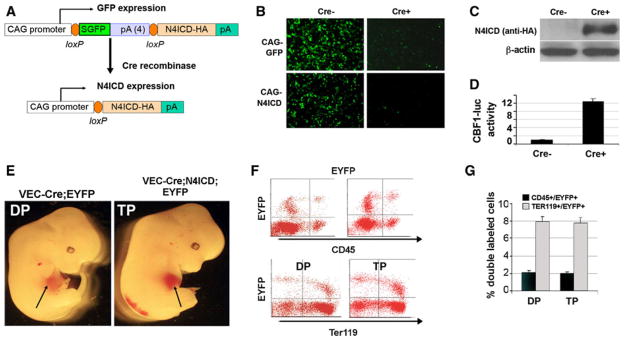Fig 2.

Expression of Notch4ICD in VE-cadherin-expressing populations does not impede hematopoietic stem cell development. a The conditional Notch4ICD (N4ICD) transgenic construct drives constitutive expression of GFP in the absence of Cre recombinase. Following Cre recombination, the GFP coding sequence is excised, and N4ICD is expressed. b–c The CAG-GFP and CAG-N4ICD constructs were validated in 293T cells without Cre recombinase (Cre−) or using co-transfection of a CMV-Cre expression plasmid (Cre+). GFP expression was monitored by immunofluorescence microscopy. c Cell lysates from the 293T experiment were collected, and CAG-N4ICD lysates were immunoblotted with anti-HA to detect N4ICD or β-actin as a control. d A CBF1–luciferase reporter construct was cotransfected with CAG-N4ICD in the absence (Cre−) or presence (Cre+) of CMV-Cre plasmid into 293T cells. Normalized luciferase activities are presented as mean ± standard deviation. e Gross appearance of control VE-cadherin-Cre;EYFP double positive transgenics (DP) compared to VE-cadherin-Cre; Notch4ICD; EYFP triple positive transgenic embryos (TP) at E12.5. The fetal liver is indicated by arrow. f Analysis of EYFP+ cells by flow cytometry in the fetal liver obtained from E12.5 VE-cadherin; EYFP double transgenic embryos (DP) or VE-cadherin; Notch4ICD; EYFP triple transgenic embryos (TP). Shown are representative flow cytometric analyses of fetal liver cells stained to detect CD45 or Ter119. g Quantitative analysis of the percentage of double positive CD45 and EYFP or Ter119 and EYFP in each genotype. Bars represent mean ± standard deviation
